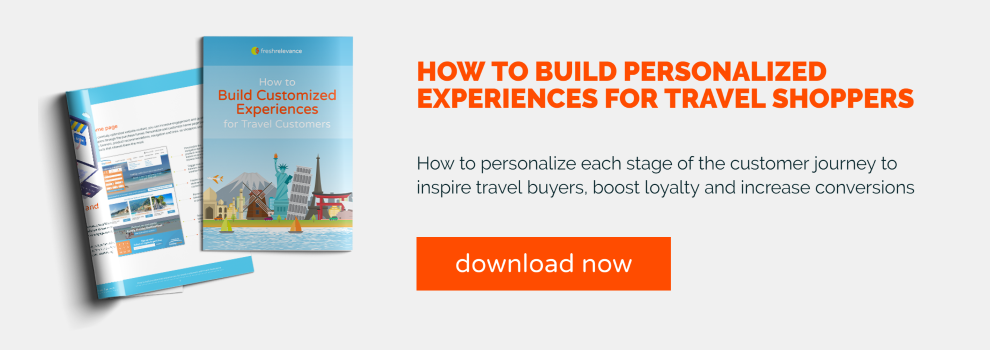Introduced by futurist Alvin Toffler in his 1970 book, ‘Future Shock’, the theory of ‘overchoice’ is the phenomenon in which people have a difficult time making a decision when faced with too many options. Having too much choice becomes mentally draining because each option must be weighed against alternatives to select the best one.
It’s an all too familiar trend for many holidaymakers who spend hours trawling travel companies’ websites for the best vacation deals – no matter whether they’re looking for deals on staycation cottages or last minute flights to Europe.
A study by Expedia found that, on average, consumers will visit 38 websites before making a booking. And our own research into leisure travel booking habits reveals that nearly half of UK holidaymakers spend longer researching and booking a vacation than the duration of the trip itself. What’s more, 1 in 3 consumers (34%) are actually spending more time on the booking process post-pandemic.
Everywhere consumers turn there is choice; you only have to scroll through a travel industry website to see it in action. On top of this, consumers are bombarded with generic emails highlighting the latest offers or a slash in price on flights, hotels and even car hires.
So are travel and tourism companies overwhelming the average consumer and as a result damaging sales?
Our research reveals that customer expectations are high and that consumers are becoming increasingly frustrated by one-size-fits-all travel and tourism marketing tactics, finding them more of hindrance than a help. More than 1 in 4 consumers admitted to feeling frustrated with the number of promotions they get for irrelevant holidays. These include receiving offers for a season in which they never go on vacation or for a type of holiday they’ve never booked, such as skiing.
In a crowded marketplace, it can be hard to maintain a competitive edge and remain profitable. Consumer expectations are constantly evolving, and many travel industry businesses are failing to adapt to these changing needs fast enough. Despite having access to vast amounts of customer data, travel businesses are lagging behind in using this data to gain valuable insights on customers and to tailor their marketing accordingly. This can harm these businesses when they target new customers and can also harm customer loyalty.
Our research shows there’s a growing population of bookers who want a more personalized and streamlined experience when booking a holiday, ultimately to make the decision-making process a little easier. Nearly 1 in 3 consumers said they stay loyal to travel companies whose websites are easy to navigate and make it easy for them to find relevant trips. This means brands that don’t provide this risk losing customers to competitors who apply a smarter approach to their travel marketing. A fully-tailored digital customer experience is key when it comes to online brands.
Reassessing marketing strategies for the year with a strong focus on delivering a seamless experience across the whole customer journey ensures travel brands are keeping up with changing consumer demands.
Make sure you collect data that’s relevant, so that you can provide a tailored customer experience, as explained below.
5 ways to provide a tailored customer experience
Tailored product recommendations
One way travel marketers can provide a more tailored customer experience is by prominently displaying the offers that are most likely to resonate with each shopper, for example by displaying personalized recommendations on the homepage based on the shopper’s past browsing and purchase data. This works with existing and potential customers.
Learn more: 5 steps to launching a product recommendations program
Social proof
On top of this, as a travel marketer, you can leverage social proof tactics, such as user-generated photos from social media, ratings and reviews, in their email and website marketing to boost trust and help customers filter through the noise and find the deal that’s right for them. Mixing this with personalized interactions can set you above other travel and tourism industry brands.
Learn more: How travel brands leverage social proof to drive online engagement
Geotargeting
As a business in the travel industry, you can also utilize geotargeting tactics, customizing content and tailoring product recommendations based on a shopper’s location.
Learn more: How travel companies can provide a better customer experience with geotargeting
Triggered emails
Maybe your customer got distracted whilst looking at holidays, or told themselves they would go back to booking later, but never returned. You don’t have to miss out on all that lost revenue; you can send cart and browse abandonment messages. These can be sent via email or SMS, and can remind customers to finish making that booking.
Onsite popovers
What if your customers do come back to your website after browsing? It’s the perfect opportunity for you to use an onsite popover, inviting them to continue exactly where they last left off.
In the year ahead, effectively communicating with audiences will remain challenging as the travel sector competes to stay relevant. Constantly listening to customer feedback will be crucial. The good news is that travel brands are in a unique position to build deep emotional connections with consumers and to create rich customer experiences. Brands that whole-heartedly embrace this will be best positioned to meet the demands of consumers this year.







